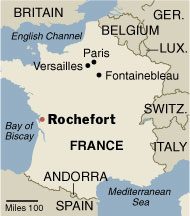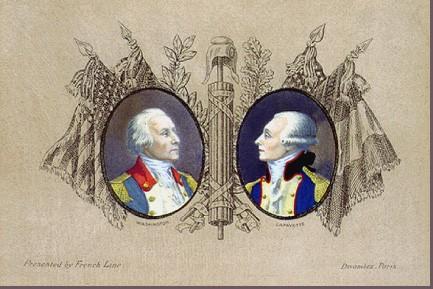
LAFAYETTE AND ABOLISHMENT OF SLAVERY
In 1794, on February 4, the French Convention votes abolishment of slavery in the colonies. This decision essentially aims at rallying the revolted slaves in Santo Domingo. It unfortunately will not be applied everywhere. Napoleon 1st maintains slavery after the Treaty of Amiens (law of May 2, 1802). On June 30, 1802 the arrival in France of blacks and "colored people" is submitted to visa and on January 8, 1803 mixed marriages are forbidden except when authorized. The act of abolishment will only happen on April 27, 1848 thanks to Victor Schoelcher.
In 1619, the first slaves are brought to America. In 1863, the Proclamation of Emancipation frees the slaves in the regions in rebellion. In 1770, the quakers of New England forbid slavery. Thomas Paine and Benjamin Franklin were ardent defenders of abolishment. Franklin frees his slaves in 1772. Thomas Jefferson, George Washington, James Madison and Patrick Henry were very active in Congress for Abolishment of Slavery. And in 1865, the 13th Amendment to the Constitution of the United States outlaws slavery.
During the Revolutionary War LaFayette had very close links with the slave James Armistead. This latter had volunteered to help the French General at Richmond siege in 1781. Well before, he was a spy serving the Insurgents. During the Yorktown campaign, he supplied LaFayette with intelligence and ensured American victory. LaFayette asked for Armistead's freedom to the Virginia General Assembly in 1784. He obtained it only in 1787. As a tribute to his benefactor, Armistead adopted LaFayette's surname.
When LaFayette came back to the United States in 1824, he recognized his old companion in the crowd and took him into his embrace.
Already in 1773 LaFayette had requested Washington to consider emancipation. He participated in the life of numerous anti-slavery societies and was inspired by the works of Marquis de Condorcet.
In 1785 LaFayette had bought a land called "La Belle Gabrielle" in the French colony of Cayenne (today French Guiana). Nearly 70 slaves used to work there. LaFayette who had bought them along with the property emancipated them, paid them for their work and forbid they could be sold. When he was emprisoned during the French Revolution, his property was confiscated and the blacks sold again as slaves.
LaFayette's generous ideas helped create our modern world. Today, exploitation of benevolents and precariousness is a new form of slavery. On January 30, 2006 French President Chirac chose May 10 for Abolishment of Slavery Commemorative Day.
I dedicate this blog entry to my Friend Pascal from Gabon.
Painting: Jean-Baptiste Le Paon, General LaFayette at Yorktown attended by James Armistead, 1783.
Like to know more about La Fayette's black Companion? please discover my article on: Direct Link: http://www.socyberty.com/History/La-Fayettes-Black-Companion.159903
LAFAYETTE ET L'ABOLITION DE L'ESCLAVAGE
En 1794, le 4 février, la Convention vote l'abolition de l'esclavage dans les colonies françaises. Cette décision visant à rallier les esclaves révoltés de Saint-Domingue ne sera pas appliquée partout. Napoléon 1er maintient l'esclavage à la suite du Traité d'Amiens (loi du 20 mai 1802). Le 30 juin de la même année, l'entrée en métropole des noirs et des "gens de couleur" est soumise à visa et le 8 juin 1803 les mariages mixtes sont interdits sauf autorisation. Le décret d'abolition interviendra seulement le 27 avril 1848 grâce à Victor Schoelcher.
En 1619, les premiers esclaves arrivent en Amérique, en Virginie. En 1863, la Proclamation d'Emancipation libère les esclaves dans les régions en rébellion. Dès 1770, les Quakers de la Nouvelle Angleterre interdisent l'esclavage. Thomas Pain et Benjamin Franklin furent d'ardents défenseurs de l'abolition. Franklin libère ses esclaves dès 1772. Thomas Jefferson, George Washington, James Madison et Patrick Henry militèrent au Congrès pour l'Abolition de l'Esclavage. Et en 1865, le 13ème amendement de la Constitution des Etats-Unis met l'esclavage hors la loi.
LaFayette au cours de la Guerre d'Indépendance a été en relation étroite avec l'esclave James Armistead. Ce dernier s'était porté volontaire au siège de Richmond en 1781 pour l'aider. Il fut bien avant un espion au service des Insurgents. Pendant la campagne de Yorktown, il fournit à LaFayette de nombreux renseignements et permit la victoire des Américains. LaFayette demanda la liberté pour Armistead auprès de la Virginia General Assembly en 1784, il ne l'obtint qu'en 1787. En hommage à son bienfaiteur James Armistead prit le nom de LaFayette. Lors de son retour aux Etats-Unis en 1824, le général français reconnut son vieux compagnon dans la foule à Richmond et l'étreignit.
Dès 1773, LaFayette proposa à Washington d'envisager l'émancipation. Il participe à la vie de différentes sociétés anti-esclavagisme et s'inspira des travaux du Marquis de Condorcet.
En 1785 LaFayette avait acheté une terre "La Belle Gabrielle" dans la colonie française de Cayenne (aujourd'hui la Guyane). Près de 70 esclaves y travaillaient. LaFayette qui les avait achetés avec la propriété les émancipera, les paiera pour leur travail et interdira qu'on les vende. Lorsqu'il fut emprisonné en 1792, sa propriété fut confisquée et les noirs revendu comme esclaves.
Les idées généreuses de LaFayette ont contribué à créer notre monde moderne. Le 30 janvier 2006, le Président Chirac choisit le 10 mai comme Journée Commémorative de l'Abolition de l'Esclavage. Aujourd'hui l'exploitation du bénévolat et de la précarité est une nouvelle forme d'esclavage.
Je dédie cet article à mon Ami gabonais Pascal.
Illustration : Jean-Baptiste Le Paon : Le Général LaFayette à Yorktown assisté de James Armistead (1783).
Pour en savoir plus sur le compagnon de la Fayette, découvrez mon article sur : Lien Direct :



Aucun commentaire:
Enregistrer un commentaire